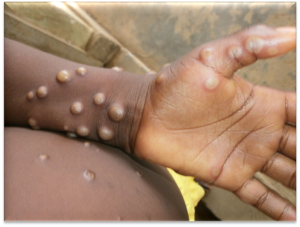 Dr Padmalaya Das, Bhubaneswar, August 6, 2022: Human monkeypox disease is not a newly identified disease. The first case was identified in a 9 month old child in 1970 in the Democratic Republic of the Congo.
Dr Padmalaya Das, Bhubaneswar, August 6, 2022: Human monkeypox disease is not a newly identified disease. The first case was identified in a 9 month old child in 1970 in the Democratic Republic of the Congo.
Since then, human cases of monkeypox have been reported in several African countries including Benin, Cameroon, the Central African Republic, the Democratic Republic of the Congo, Gabon, Liberia, Nigeria, the Republic of the Congo, Sierra Leone and South Sudan. Outbreaks of the disease have been reported intermittently from central and west African countries.
Monkeypox is a viral zoonosis (a virus transmitted to humans from animals) with symptoms similar to that of smallpox, but clinically less severe. It presents with fever, skin rashes, and swollen lymph nodes.
Complications of monkeypox can include secondary infections, bronchopneumonia, sepsis, encephalitis, and infection of the cornea with ensuing loss of vision. The extent to which asymptomatic infection may occur is unknown.
It appears small pox exposure or vaccination in the past provides protection against human monkey pox, therefore, persons younger than 40 to 50 years of age are more susceptible to monkeypox.
With the eradication of smallpox in 1980 and subsequent cessation of smallpox vaccination, monkeypox has emerged as a public health importance.
The exact mode of transmission of human monkey pox disease is not clearly known. Human-to-human transmission can result from close contact with respiratory secretions, skin lesions of an infected person or recently contaminated objects.
Transmission via droplet respiratory particles is also reported, thus making the health workers, household members and other close contacts of active cases vulnerable to the disease.
Although it is predominantly reported in male homosexuals, it is unclear at this point of time if monkeypox is specifically transmitted through sexual transmission routes.
A recent report published in New England Journal of Medicine (published on July 21, 2022), showed that out of 528 infections diagnosed between April 27 and June 24, 2022, from 16 countries, about 98% of the persons with infection were either gay or bisexual men, and 41% had HIV infection; the median age was 38 years.
Transmission was suspected to have occurred through sexual activity in 95% of the persons with infection. Animal-to-human (zoonotic) transmission can occur from direct contact with the blood, bodily fluids, or cutaneous or mucosal lesions of infected animals.
In Africa, evidence of monkeypox virus infection has been found in animals such as squirrels, Gambian pouched rats, different species of monkeys and many others. However, the rodents appear to be the most likely source of infection; in which sense the term “Monkey Pox” appears a misnomer.
 Unfortunately, even after more than half a century after the disease was first reported in humans, the definite mode of transmission of the disease, natural reservoir of monkeypox virus, clinical presentation, and the therapeutic and preventive measures are not known.
Unfortunately, even after more than half a century after the disease was first reported in humans, the definite mode of transmission of the disease, natural reservoir of monkeypox virus, clinical presentation, and the therapeutic and preventive measures are not known.
It has started drawing attention of the scientific community and the policy makers recently, only after the disease has appeared in developed countries.
With the increasing air travel world over, it is naïve to think that any communicable disease will remain confined to its source of origin for long. This situation is true for many other zoonotic diseases.
Animals can sometimes carry harmful germs that can spread to people and cause illness – these are known as zoonotic diseases or zoonoses. Animals may appear healthy even when they are carrying the germs that can make humans sick.
The zoonotic diseases include viral (rabies, yellow fever, chandipora virus, Nipah virus, etc.), bacterial (anthrax, brucellosis, plague, leptospirosis, salmonellosis, etc.), rickettsial (typhus fever), protozoal (toxoplasmosis, leishmaniasis, trypanosomiasis, etc.), helminths (hydatid disease, schistosomiasis, etc.), fungal (histoplasmosis, cryptococcus, etc.).
In India, the most common zoonotic diseases include leptospirosis (rodents are the primary reservoir, but many other animals may be potentially involved), rabies (dogs as primary reservoir, bats also recognized), and Nipah virus (fruit bats as primary reservoir). Leptospirosis and rabies kills many people throughout the subcontinent. Nipah virus is associated with high case fatality.
Threats posed by zoonotic diseases are global but especially pertinent in low-income countries, where a range of socio-economic, environmental and other contextual factors often converge to increase risks of, and vulnerability to, disease outbreaks.
The risk of zoonotic disease spread is more prominent in tropical countries, including the Indian subcontinent, that are undergoing changes in land use related to agriculture, and with high wildlife biodiversity.
A recent report from the “State of the World’s Forests 2022 report” states that India and China could emerge as the biggest hotspots for new zoonotic viral diseases if human pressure on forests continues to increase, driving increasing human wildlife interactions.
The change in climate and land use will enhance interaction between human and geographically-isolated species of wildlife, which will result in zoonotic spillover, diseases spreading from animals to humans.
This is particularly true of areas with high human population density. Human health is closely connected to animal health, and the shared environment.the ecosystem-health dimension through responsible land-use planning.



Leave a Reply
Be the First to Comment!